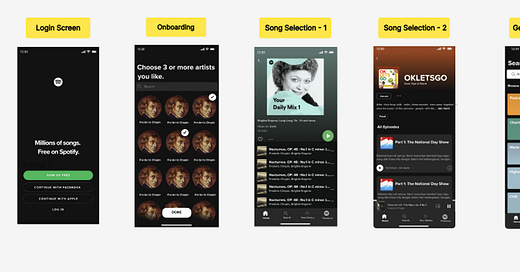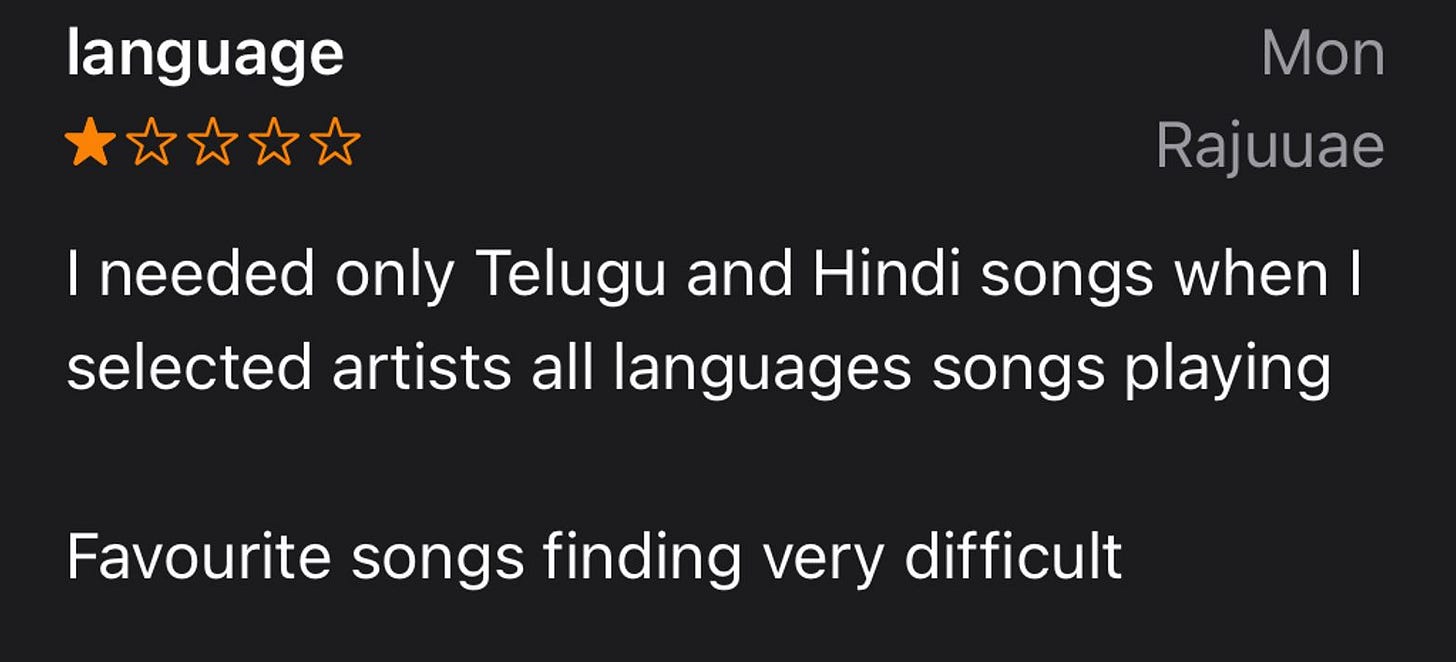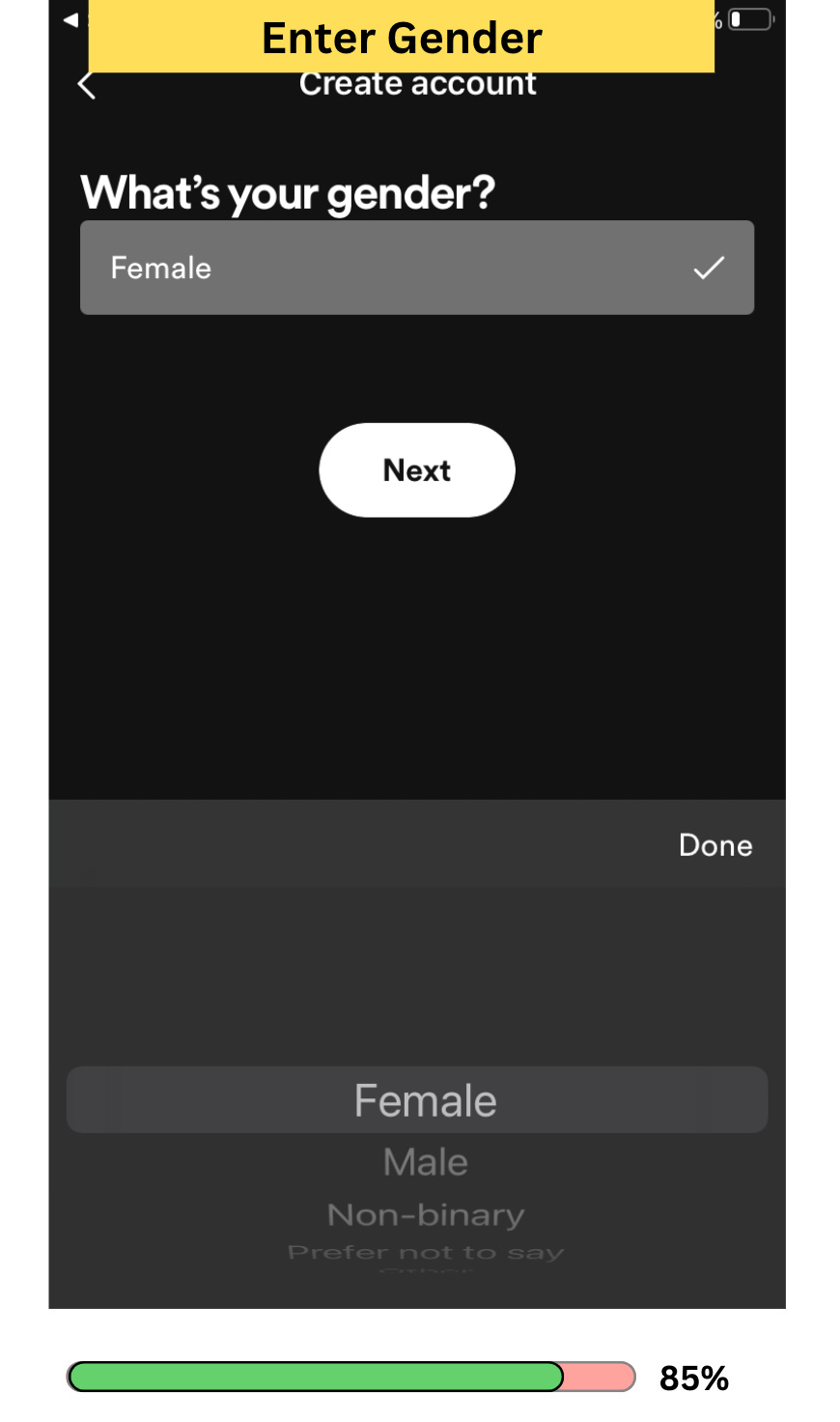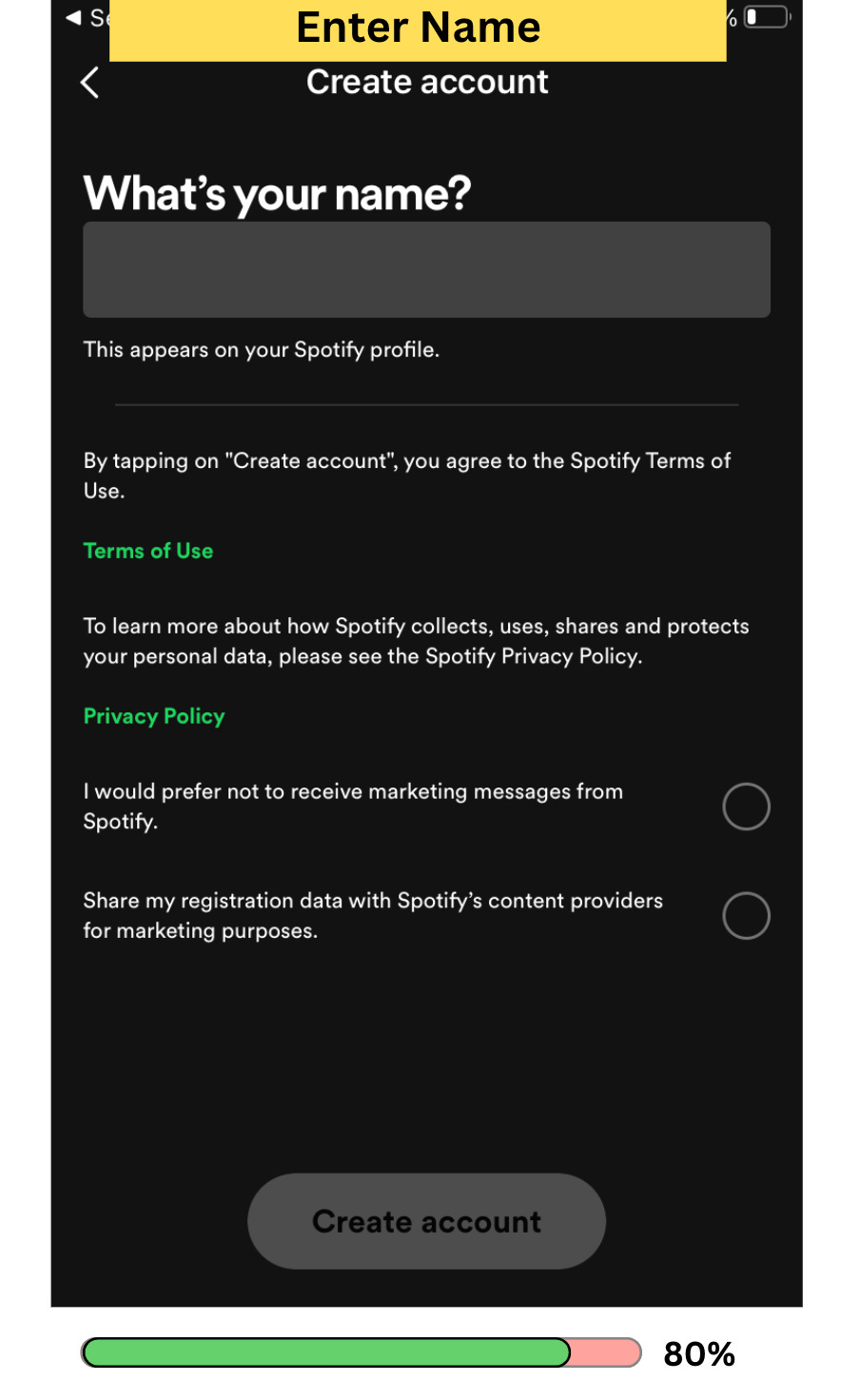Turn up the music - Spotify’s Teardown
A deep dive into the powerhouse that drives our audio consumption
First things first, I recreated Spotify’s login, onboarding, song selection and category selection screen on Figma. Creating the screens on Figma was a great learning experience. I’d recommend anyone looking to learn design to get their hands dirty than taking those boring design courses on how to get started with Figma. Here’s the link to the prototype - Link.
Next, let’s get straight into the different aspects I observed about Spotify during multiple brainstorming sessions with myself and through a secondary research.
1. First Impressions
A. How did Spotify first come to my attention?
Word of mouth. Back in college, a friend of mine suggested I give Spotify a try, even before it was a thing. I remember accessing Spotify through a VPN and playing DJ during late-night poker games in my dorm room. Good old days!
B. One line summary of what the app does at this stage?
What I thought before reading company’s official one liner
Spotify enables anyone to discover and play great music and podcasts from all across the World
Actual
Spotify is a digital music service that gives you access to millions of songs
It was a surprise to discover that Spotify had not included podcast in its meta description on Google. However, when I clicked on Spotify’s website link, podcasts appeared right at the top. This led to wonder if Spotify still primarily sees itself as a music company , despite its significant investment in podcasting.
C. What others think about the app?
My closest friends and family members relate Spotify to music and podcast. Music and Podcasts are the central entity of the Spotify app. Every verb revolves around that.
Play a song/podcast
Add a song/podcast to a playlist
D. What do customer reviews, ratings and descriptions say?
Spotify has a rating of 4.7 across 1.5M reviews. While most people love Spotify’s song/podcast collection and experience, there are some issues reported by the customers repeatedly. I’ve listed some of them below:
The number one problem mentioned on the Appstore is high frequency of ads for non subscribers. Customers are annoyed by the frequency (after one song) and the kind of ads (same ads on loop). Customer’s find the promise of “no ad for the next 30 mins” even more annoying as Spotify serve ads after every 2nd song
Unable to subscribe/upgrade plan through the app - Customers find it really difficult to subscribe to Spotify/upgrade their plan as there are no clear instructions to subscribe on their mobile app. I think Apple has a key role to play in the absence of a direct subscription link which redirects the users to purchase Spotify’s subscription.
Recommendations in the same language - Due to the multitude of languages spoken in India, users prefer to receive song recommendations in the same language they are currently listening to. For instance, if a user is playing a Kannada song, they would expect a recommendation for another Kannada song rather than one in Telugu.
As per the users' app reviews on the App Store, the following are some of the features requested by the users:
Search within playlists
Reorder songs inside a playlist
Put the newly added song to the playlist at the top
How to pay? Not able to pay through the app
Create folders for podcasts
Create two difference sections for podcasts and music
Let users pick the ads genre
2. Onboarding
A. What’s the experience of getting started or signing up
I downloaded the app to listen to the latest episode of the Huberman podcast asap. As I went through each step of the app onboarding process, I noted down my observations
Okay, let’s go
Too many Signup/Sign In options, but I am able to find the one that I want to go ahead with 😊 . Sign Up with Gmail 🚀
Why am I being asked to share my date of birth without any reason. How will it help Spotify? I’m skeptical now. Spotify don’t be evil 😈
Again, I have no idea why Spotify needs this information. How will inputting this information make my podcast listening experience better.
A series of questions is annoying when I just want to hear Huberman’s podcast. Lets get passed this quickly Spotify
Where are podcasts? 😭 Does Spotify not have podcasts at all. I’m restless after investing so much
I randomly selected music artists because I am impatient to discover great podcasts and start listening to the latest episode of Huberman podcast.
This screen filled me with delight!
Not only am I not able to see a podcast section, I am unable to see the artists/ songs from the artists that I just selected. I am curious why Spotify asked me to select artists on the previous screen. Let’s search for Huberman podcast.
There it is. The podcast menu. I’m finally relieved to see that Spotify has podcasts. I’ll come back and listen to Huberman podcast later today. While I waited for a long time to reach this state, I am unsure if other new users will. ⌛
B. How does this app explain itself in the first minute?
Spotify does not prioritize podcasts, even in its onboarding screens. Rather, it promotes itself as the platform to discover and enjoy millions of songs.
C. What are the main jobs a user might have hired this product for?
There are two core jobs that a user hires Spotify for:
Discover and Listen to songs - listen to their favorite songs, playlists, or albums, discover new music, or simply enjoy some background music while working, studying, or relaxing.
Discover and Listen to podcasts
After playing around with Spotify for years, I have seen my friends hire Spotify to get the following jobs done:
Discover new songs and playlists recommended by the Spotify app such as Discover Weekly, Release Radar etc. - Push notification or by themselves
Check to see if a particular song or a podcast exists on Spotify
Add a song or podcast episode to a new/existing playlist
Download music/podcast
Checkout friends activities or listen to their songs/playlists
3. Product Experience and Growth
A. What do I think the north star of this product is?
Spotify generates its revenue from two activities. Subscriptions and ads. In my opinion, Spotify’s northstar is number of monthly active users. The following metrics are very important to track its revenue growth:
No. of users (old and new) playing atleast one song per day and month
% of MAUs converting to subscribers
No of ads served per day and month
Contribution of revenue from subscriptions and ads
B. What are the experiments I would run?
Based on the user’s feedback, I would want to run the following experiments:
Experiments to increase revenue
Find out the optimal time/ number of songs after which an ad should be served. Success metrics : NPS, retention Check metric : ads revenue
Redirect users to subscribe on Spotify’s website through audio ads
Discounts on Spotify subscription for new and expired users after a certain amount of time spent listening on the app
Onboard popular podcasters and signing exclusive deals with them
Introduce podcast summaries and charging a high tiered subscription price if the experiment is successful
Allow users to save podcast snippets and save them in a folder
Experiments to drive retention
Allow users to create folders to save podcasts
Allow users to search within a playlist
Place the newly added song within the playlist on top
C. How big is the market?
Global online music streaming market size is estimated to be around $25 billion with an estimated growth rate of 19.8% (by ResearchAndMarkets)
D. How did Spotify grow?
Content Supply Growth
Targeted Business Development - Spotify initially partnered with record labels in areas that were most affected by piracy to grow its supply side. For eg. Sweden, where Spotify was founded, had a high rate of music piracy prior to the introduction of Spotify. Spotify's entry into the Swedish market provided a legal alternative for music streaming and promised increased revenues for the record labels.
Revenue Sharing Guarantee - Spotify signed licensing agreements with record labels and publishers that offered them minimum revenue guarantees. These guarantees ensure that the labels and publishers receive a certain amount of revenue from Spotify, regardless of the actual streams or revenue generated by their music on the platform
Record Labels as Shareholders - Spotify invited all the major record labels to become a shareholder and take a stake in the company.
Exclusive Deals - Spotify has signed exclusive deals with music labels, podcast creators, and celebrities to offer exclusive content on the platform. This exclusive content is not available on other streaming services, which helps to attract new users and retain existing ones.
Acquisitions : Spotify has acquired several podcasting companies, including Gimlet Media and Anchor, to expand its podcast offerings. Such acquisitions has helped Spotify onboard the creators on those platform and join Spotify’s ecosystem
Listener Growth
Strategic Partnerships: Spotify has formed partnerships with mobile carriers and device manufacturers to offer free or discounted access to the service. These partnerships have helped to increase awareness of the platform and attract new users. For example, in India, Spotify partnered with telecom operator Jio to offer free access to its premium service for Jio users. This helped to attract millions of new users to the platform. Spotify has gradually expanded its service to new countries over time, starting with its launch in Sweden in 2008 and expanding to other European countries in the following years. As Spotify's popularity grew, it continued to expand to new regions, including North America, South America, Asia, and Africa. Spotify typically chose to launch in markets where it believed there was a strong potential for growth and where the competitive landscape was favourable.
Acquisitions: Spotify has acquired companies in different regions to help expand its service offerings and reach new audiences. For example, in 2018, Spotify acquired Anghami, a leading music streaming service in the Middle East and North Africa region. This acquisition helped Spotify to enter the Middle Eastern market and expand its offerings in the region.
Selective launch across different countries - Before entering a new market, Spotify would conduct extensive market research to understand the local music landscape, consumer preferences, and competitive landscape. Spotify would then work to secure licensing deals with record labels and music publishers in each market. These deals were critical to securing the rights to the music that would be available on the platform.
Marketing and Promotion : Spotify launched marketing and promotional campaigns to build hype and attract new users. This included a mix of online advertising, social media marketing, and partnerships with local brands and influencers. Here’s one such campaign
Product Features:
Social Share : Spotify allows users to share their playlists and listening habits on social media, which helps to promote the platform and attract new users through word-of-mouth.
Localized Features : Spotify would also tailor the service to each market by offering localized features, such as curated playlists and recommendations that were tailored to local music preferences. This helped to make the service more appealing to local users and differentiate it from competitors.
Word of Mouth : Superior discovery, listening experience and a wide music catalogue made the early users feel cool amongst their social circle and drove a strong word of mouth marketing.
How will Spotify grow from here?
Increase its catalogue and sign more exclusive deals to scale its supply. Unlike Uber’s case, there is no limit to how much Spotify can scale its supply (content)
Building tools and analytics for artist to be easily discoverable and promote themselves. Unlike social media marketing tools, these promotions will be visible to users who have actively made a decision to open Spotify and listen to music
Letting users subscribe to paid podcasts through RSS feed so that they can listen to their favourite podcasts on Spotify even when Spotify has not a direct partnership with that podcast channel/podcaster. This is also a huge value add for podcasters as they will be able reach Spotify’s 500 million monthly active users which means a new customer acquisition channel for them
Doubling down on Podcasts : Differentiate its service from its competitors such as Apple Music and add content that it does not have to pay for on a marginal cost basis
Experimenting with new content formats such as a video feed like TikTok that will let users discover new songs, podcasts and books. Spotify calls this foreground discovery
4. Defensibility
A. What is the moat?
Recommendations is one of the biggest moats for Spotify. The more I’ve used it, the better it has become. It suggests me relevant music, podcasts, music genre and categories that I am most probable to like
Creating songs/podcast playlists - Adding songs/playlists to Spotify increases the likelihood of me coming back to the app
Discovery - Spotifys daily, weekly discovery is one of the best features that keeps me hooked when I’m in the mood to discover new music
Content - After going through the user feedback, it is clear that users love Spotify’s large catalogue of songs and podcasts. Spotify also has exclusive deals with some of the most popular podcasters such as Joe Rogan. This exclusive content is not available on other streaming services, which helps to attract new users and retain existing ones.
Language - Spotify serves audio content to a large user base who come from different parts of the World and speak different languages. A large catalogue of music and podcast content that cater to the needs of these diverse set of user base is one of the biggest moat for Spotify
Platform integrations - Spotify has integrated its music streaming service into other popular platforms, such as Facebook, Instagram, Snapchat, Carplay etc over the past years. These integration allows users to share music with their friends, create and join listening parties, and increase the surface area for top of the mind awareness and user retention on Spotify.
Social - Spotify enables users to follow their favorite artists and friends to keep up with their latest releases, concerts, or playlists. Users may open the app to see what their friends or artists are listening to or share their own activity with others.
Brand - Last, but not the least, Spotify has established itself as one of the biggest brands in the music industry. It is hard for a new player. Spotify is widely recognized as the leader in music streaming. This brand awareness gives it an advantage in attracting new users and retaining existing ones, as users are more likely to choose a brand they are familiar with over a lesser-known competitor.
B. How is the app increasing the switching cost?
Spotify doesn’t let bulk export your export your songs, music, playlists
Partnering with more popular artists and podcasters such as Ben Thompson to distribute their content through Spotify without taking a cut
Helping users discover new live events near them and buying tickets
Allowing users to blend, mix songs and create playlists with their friends and artists
Communicating end of year listening history to users in a delightful experience
More Resources
Earnings Call Event - Link
Spotify’s Q1 Shareholder Deck 2023 - Link
Spotify’s Earnings Call - Link






















